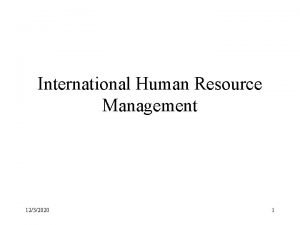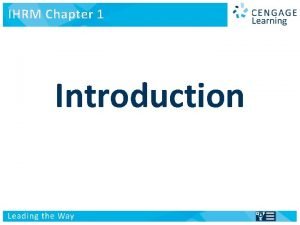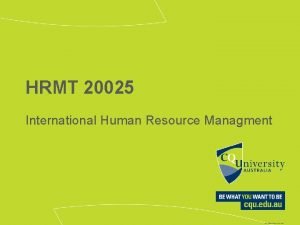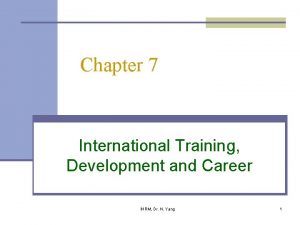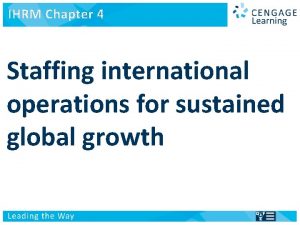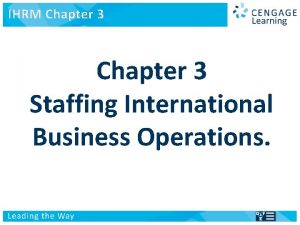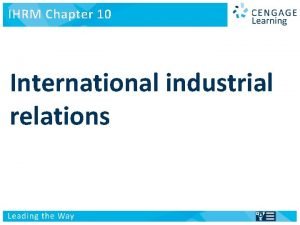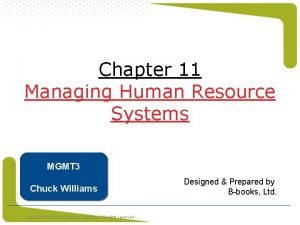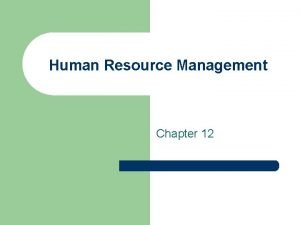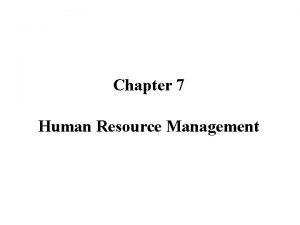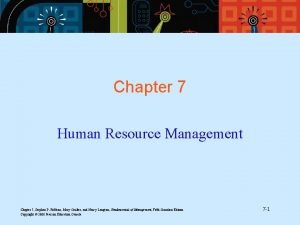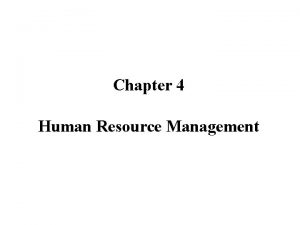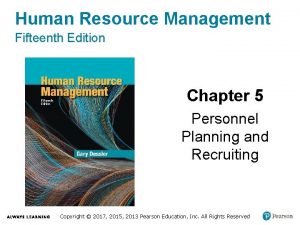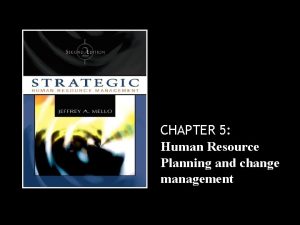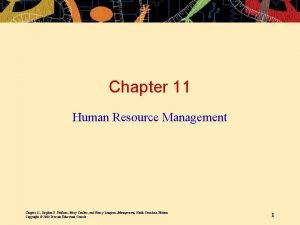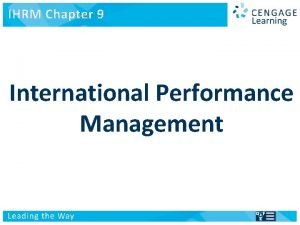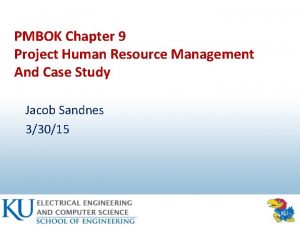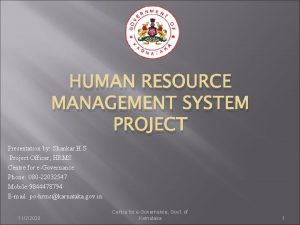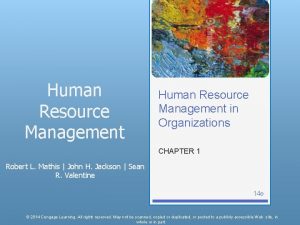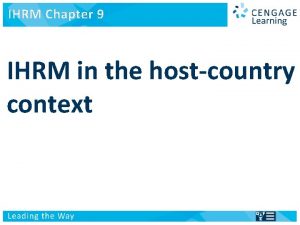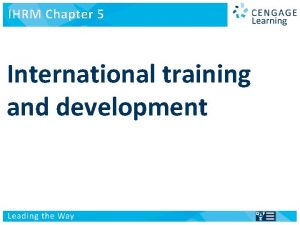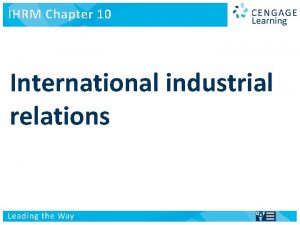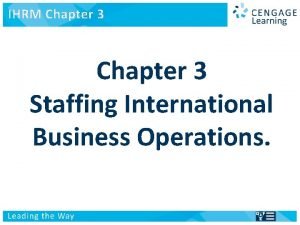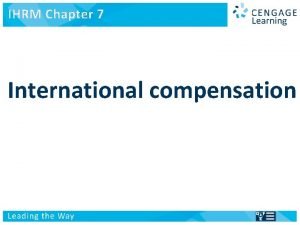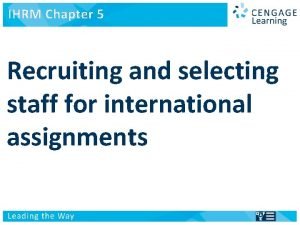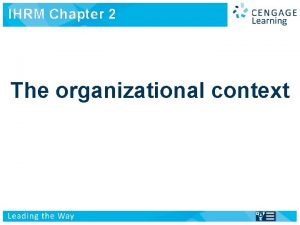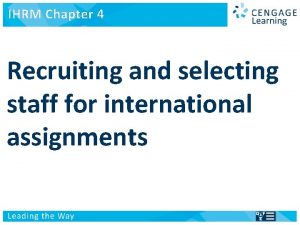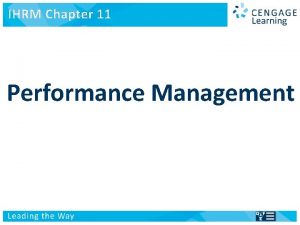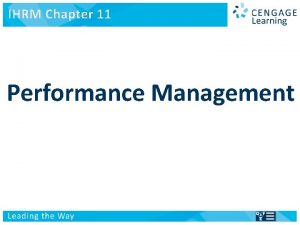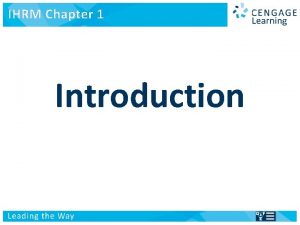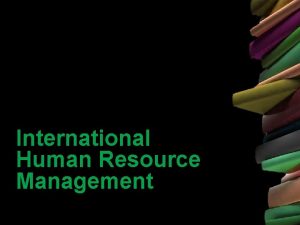IHRM Chapter 3 International Human Resource Management Chapter







































- Slides: 39

IHRM Chapter 3 International Human Resource Management Chapter 3 Staffing International Business Operations. Managing people in a multinational context

Chapter Objectives We focus on the ‘managing the people’ aspect of IHRM: • Issues relating to staffing foreign operations • The reasons for using international assignments: filling positions and developing managers and organizations. • Various types of international assignments: short term, extended and longer term; • Various non-standard arrangements: commuter, rotator, contractual and virtual • The role of expatriates and non-expatriates in supporting international business activities • Return on investment of international assignments • The role of the corporate HR function in MNEs v 2

Terms Expatriate roles: Assignments: short-term extended agent of direct control traditional agent of socialization commuter language node ROI approach rotational network builder contractual virtual boundary spanner inpatriates expatriates flexpatriates v Approaches to staffing: ethnocentric polycentric geocentric regiocentric 3

Terms of HCN, PCN & TCN Host Country nationals (HCN) • Natives of the host country • A subsidiary Parent Country nationals (PCN) • Who are typically defined as citizens of the country of the HQs of the MNE and employed by the firm in the country of its HQs. Third Country national (TCN) • Natives of a country other than the home country or the host country • ‘Others’ countries that may be the source of labor, finance, and other inputs. v 4

Staffing Approaches. • 4 terms describe MNE approaches to managing & staffing their subsidiaries. –Ethnocentric –Polycentric –Geocentric –Regiocentric. v 5

Ethnocentric • Few foreign subsidiaries have any autonomy & strategic decisions are made at HQ. • Key positions in domestic & foreign operations are held by HQs’ personnel. • Subsidiaries are managed by staff from the home country (PCNs). • Reasons for pursuing an ethnocentric staffing policy: – Lack of qualified host country nationals(HCNs) – Need to maintain good communication, coordination & control link with corporate HQ and reduce high risk at initial stage. v 6

Disadvantages Ethnocentric Policy • Limit the promotion opportunities of HCNs lead to reduced productivity & increased staff turnover among that group. • Adaptation of expatriate mangers to host countries often takes a long time during PCNs often make mistakes and poor decisions. • Imbalance or unjustified compensation packages between PCN & HCN. • For expatriates a key oversea position means new status, authority & an increase in standard of living that will effect expatriates’ sensitivity to the needs and expectation of their host country subordinates. v 7

Polycentric • The MNE treats each subsidiary as a distinct national entity with some decision making autonomy. • Subsidiaries are usually managed by local national (HCN’s) who are seldom promoted to position at HQ and PCNs are rarely transferred to foreign subsidiaries positions. v 8

Advantages Polycentric Policy • Employing HCNs eliminates language barriers, avoid the adjustment problems of expatriate managers and their families and remove awareness training programs. • Employment of HCNs allows a multinational company take a lower profile sensitive political situations. • Employment of HCNs is less expensive even if a premium is paid to attract high quality applicants. • Give opportunity to the mgt. of foreign subsidiaries. Avoid the turnover of key manager. v 9

Disadvantages Polycentric Policy • Bridging the gap between HCN subsidiaries managers and PCN managers at corporate HQ in term of language barrier conflicting nationals loyalties and etc. • Career paths of HCN & PCN managers. Host Country managers have limited opportunities to gain experience outside their own country and cannot progress beyond the senior position in their own subsidiaries. v 10

Geocentric • The MNE is taking a global approach to its operations, recognizing that each part (subs & HQ) makes a unique contribution with its unique competence. • It is accompanied by a worldwide integrated business & nationality is ignored in favor ability. • This is a major goals the European telecommunication company Vodafone would like to achieve. v 11

Advantages Geocentric Policy • Enables a multinational firm to develop an international executive team which assist in developing a global perspective. • Overcomes the ‘federation’ drawback of the polycentric approach. • It supports cooperation & resource sharing across units. v 12

Disadvantages Geocentric Policy • Host govrn. want high no. of their citizens employed and may utilized immigration control in order to force HCN employment if enough people and adequate skills are available or required training of a HCN over a specified time. • Many Western countries required companies to provide extensive documentation if they want to hire foreign national instead of a local national. • Expensive because to implement required training and relocation costs. • Large no. of PCNs’, TCNs’ and HCNs’ need to be sent abroad in order to build and maintain the international team required geocentric staffing policy requires longer time& process. v 13

Regiocentric • Reflects the geographic strategy and structure of the MNE. • Utilize a wider pool of manager but in a limited way. • Staff may move outside their countries but only within the particular geographic region. • Regional managers may not be promoted to HQ positions but enjoy a degree of regional autonomy in decision making. v 14

Advantages Regiocentric Policy • Allow interaction between executives transferred to regional HQ from subsidiaries in the region and PCNs’ posted to the regional & PCNs posted to the regional HQ. • Reflect some sensitivity to local conditions since local subsidiaries are staffed almost totally by HCNs. • It can be way for a multinational to gradually move from a purely ethocentric or polycentric approach to a geocentric approach. v 15

Disadvantages Regiocentric Policy • Can produce federalism at a regional rather than a country basis and constrain the organization from taking a global stance. • Improve career prospects at the national level, only moves the barrier to the regional level. Staff may advance to regional HQ but seldom to position at the parent HQ. v 16

Table 4 -1 a v The advantages and disadvantages of using PCNs 17

Table 4 -1 b v The advantages and disadvantages of using TCNs 18

Table 4 -1 c v The advantages and disadvantages of using HCNs IHRM Chapter 4 19

Determinants of staffing choices Context Specificities. – The local context of the HQ and subsidiary can be described by cultural and institutional variables. – Cultural values may differ to a high extent between the HQ & the host country context. Company Specific Variables. - Depicted from the framework on strategic HRM in MNEs’. - Variable are MNE structure & strategy, international experience, corporate governance & organizational structure which describe the MNE as a whole. Local unit specificities. - Staffing approach may vary with the cultural & institutional environment it may also be dependent on the specificities of the local unit. v 20

Determinants of staffing choices - Important factor is the establishment method of the subsidiary i. e. merger, acquisition, share partnership and etc. – Cultural values may differ to a high extent between the HQ & the host country context. IHRM practices - Including HRM functions such as selection, T&D, C&B & career mgt. including expatriation as well as repatriation in a border firm context. v 21

Figure 4 -1 v Determinants of staffing choices 22

Reasons for International Assignments 3 key organizational reasons for the use of various of international assignment: 1. Position filling • The organization has a need and depending on the type of position and the level involved will either employ someone locally or transfer a suitable candidate. • To fill the gap • Launch of a new endeavor & technology transfer v 23

Reasons for International Assignments 2. Management Development • Staff can be moved into other parts of the organization for T&D purposes and to assist in the development of common corporate values. • The perceived link between international experience & career development can be a motivation for staff to agree to such transfers. v 24

Reasons for International Assignments 3. Organizational Development • Company strategic objective of the operation come into play: the need for control, the transfer of knowledge, competence, procedures & practices into various locations & to exploit global mkt. opportunities. • As a result organizational capabilities enabling a firm to compete in global mkt. might be developed. • Greater staff mobility assisted in supporting a global corporate culture & assisted the crossfertilization of ideas & practices. v 25

Types of International Assignments Short term • up to 3 months. • Usually for troubleshooting, project supervision or a stopgap measure until a more permanent agreement can be found. • Extended • up to 1 year • Involve similar activities for short-term assignment. • Long term (traditional expatriate assignment) • 1 to 5 years. • v 26

Types of International Assignments • 1 to 5 years. • Involving a clearly defined role in the receiving operation ( such as MD of subsidiary) • The long term assignment has also been referred to as a traditional expatriates assignment. v 27

Non Standard Assignment Some non-standard assignments: • Commuter assignment • Special arrangement where the person concerned commutes from the home country • On a weekly or bi-weekly basis to the place of work in another country. • Family of the assignee stays in the home country. • Rotational assignment • Employees commute from the home country to a place of work in another country for a short. • Set period followed by a break in the home country. v IHRM Chapter 4 28

Non Standard Assignment • Family usually remains in the home country. • Contractual assignment. • Used situations where employees with specific skills vital to an international project are assigned for a limited duration of 6 to 12 mths. • R&D is one area using multinational project teams and lends itself to STC assignment in conjunction with LTC assignments a virtual teams. v IHRM Chapter 4 29

Non Standard Assignment • Virtual assignment. • Employees does not relocate to a host location but manages from home base, intern. responsibilities for a part of the organization in another country • Manager relies on communications technologies i. e telephone, email, VC. • Frequent visit to the host country are necessary. v IHRM Chapter 4 30

Table 4 -2 v Differences between traditional and short-term assignments 31

Expatriate Roles. • Agent of direct control. • The use of staff transfer can be regarded as a bureaucratic control mechanism, where the primary role is that of ensuring compliance through direct supervision. • Ensuring subsidiary compliance, enabling strategic objectives for local operations to be achieved. • Agent of socialization • Related to the use of corporate culture as an informal control mechanism. • Expatriates assist in the transfer of shared values and beliefs. v IHRM Chapter 4 32

Expatriate Roles. • Attempts to instill corporate values & norms. • Network builder • International assignment are viewed as a way of developing social capital; fostering interpersonal linkages that can be used for informal control & communication purpose. • Boundary spanners • Refer to activities such as gathering info. that bridge internal & external organizational contexts. • Expatriates are considered boundary spanners because they can collect host country info. Act as representative of their firms in the host country and can influence v 33 IHRM Chapter 4 agent.

Non-Expatriate Roles. People who travel internationally yet are not considered expatriates as they do not relocate to another country. Non expatriate internationally traveler person for whom a large proposition of their role involves constant international visit to foreign mkts, subsidiary units and international project. • • v IHRM Chapter 4 34

Inpatriate Roles. If organizations work on a global scale they need sufficient qualified staff to meet the requirement of globalization. To support this process a new term for the mgt. development of a specific type of HCN called expatriates. Serve as ‘linkage pins’ between the different organizational units of an MNE. • • • v IHRM Chapter 4 35

Figure 4 -2 v The roles of an expatriate 36

Figure 4 -3 ROI indicators for calculating international assignments v 37

4 -steps to calculate expatriate ROI 1. Identify financial and non-financial costs and benefits. 2. Link the costs and benefits to the purpose of the long-term assignment. 3. Identify the appropriate antecedents from a system’s perspective. 4. Conduct the calculation at an appropriate time within the context of the assignment’s purpose. v 38

Table 4 -3 v Various roles of corporate HR 39
 What is human resource
What is human resource International human resource management dowling 6th edition
International human resource management dowling 6th edition International human resource planning
International human resource planning International human resource management
International human resource management Time management human resources
Time management human resources Organized retail
Organized retail Human resources defintion
Human resources defintion Development of ihrm
Development of ihrm Ihrm objectives
Ihrm objectives Virtual assignment in ihrm
Virtual assignment in ihrm International industrial relations in ihrm
International industrial relations in ihrm Human resource management chapter 2
Human resource management chapter 2 Chapter 9 human resource management
Chapter 9 human resource management Chapter 11 human resource management
Chapter 11 human resource management Chapter 1 introduction to human resource management
Chapter 1 introduction to human resource management Chapter 1 introduction to human resource management
Chapter 1 introduction to human resource management Human resource management 15th edition
Human resource management 15th edition Human resource management lecture chapter 1
Human resource management lecture chapter 1 Chapter 4 job analysis and the talent management process
Chapter 4 job analysis and the talent management process Functions of hrm
Functions of hrm Chapter 7 human resource management
Chapter 7 human resource management Chapter 7 human resource management
Chapter 7 human resource management Human resource management chapter 4
Human resource management chapter 4 Project management chapter 4
Project management chapter 4 Replacement chart
Replacement chart Human resource management chapter 5
Human resource management chapter 5 Chapter 11 human resource management
Chapter 11 human resource management Non expatriate
Non expatriate Project human resource management pmbok ppt
Project human resource management pmbok ppt Resource management pmbok
Resource management pmbok About human resource management
About human resource management Human resource management in restaurants
Human resource management in restaurants Induction hr meaning
Induction hr meaning Hrms shanker group
Hrms shanker group Mbo performance appraisal method
Mbo performance appraisal method Current issues in human resource management
Current issues in human resource management Ba human resource management
Ba human resource management Purpose of human resource management
Purpose of human resource management Human resources management gaining a competitive advantage
Human resources management gaining a competitive advantage Human resource management gaining a competitive advantage
Human resource management gaining a competitive advantage
